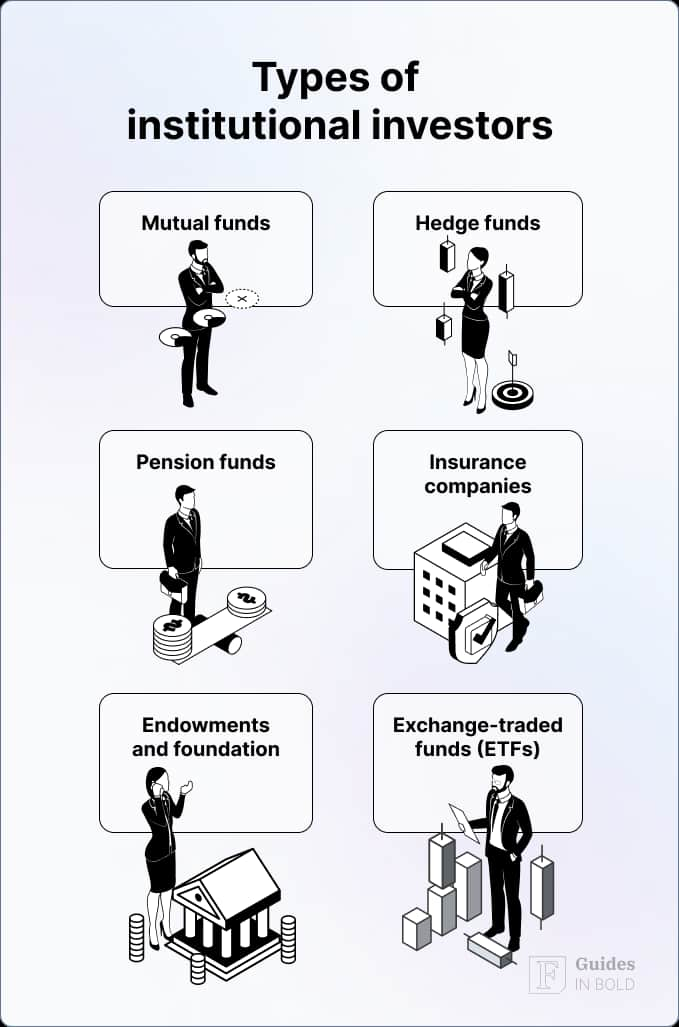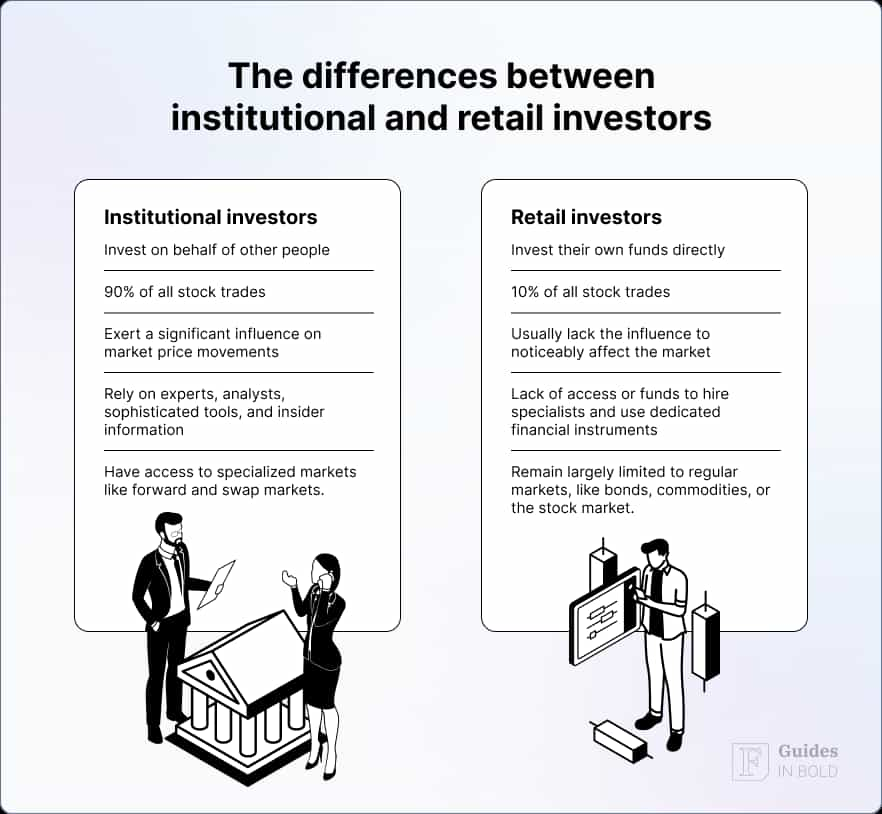Institutional investors wield substantial influence on initial public offerings (IPOs). They often set the stage for a company’s market debut, impacting its success or failure. Hence, understanding what these investors look for in IPOs can help retail investors make more informed decisions and spot valuable opportunities.
In this guide, we’ll look at the factors institutional investors evaluate and how retail investors can align their strategies.
Who are institutional investors?
Institutional investors are large organizations, such as mutual funds, hedge funds, pension funds, insurance companies, endowments and foundations, and exchange-traded funds (ETFs), that invest substantial sums of money on behalf of their clients or members.

Unlike individual investors, institutional investors have access to advanced resources, specialized analysts, and significant market influence. Their investments typically shape market trends and impact stock prices, making them key players in the financial world.

What is an IPO?
For investors, an IPO represents an opportunity to invest early in a potentially growing company. However, it can also carry risks, as the stock’s performance may fluctuate significantly once it begins trading publicly.
How to analyze an IPO?

Institutional investors analyze IPOs with specific goals—maximizing returns, minimizing risks, and ensuring steady long-term growth. Here are the main factors they look for:
#1 Strong financials and growth potential
Institutional investors prioritize companies with solid financial performance and a clear path for growth. They analyze metrics like revenue growth, profitability, and cash flow. They want to see steady revenue and clear signs of future growth, as these indicators point to the company’s ability to generate returns. In particular, they pay attention to companies in high-growth sectors such as technology and healthcare.
#2 A compelling market position
A company’s position within its industry plays a significant role in attracting institutional investors. They look for companies with a unique value proposition, competitive advantages, and minimal direct competition. If a company has strong brand recognition or owns patents and unique technologies, institutional investors see it as having a sustainable edge.
#3 Experienced management team
Institutional investors scrutinize the management team closely. They want a proven track record of leadership and execution. A management team with a history of steering companies through growth phases and economic challenges brings confidence that they can navigate the public market.
#4 Market timing and industry trends
In short, timing matters big in IPO investments. Institutional investors examine the economic environment and current trends in the company’s industry. For example, during tech booms, they may focus more on technology companies, while during stable economic periods, they might shift their interest toward consumer goods or real estate.
#5 Valuation and pricing
Lastly, institutional investors assess the IPO’s pricing relative to regulations and market stability. For more on IPO valuations and pricing standards, the US Securities and Exchange Commission (SEC) provides guidelines and resources.
Nevertheless, if institutional investors perceive a company’s valuation as too high, they may pass on the investment. Overpriced IPOs often lead to immediate stock price drops post-IPO. Fair valuations, backed by strong fundamentals, attract institutional investors who seek long-term value rather than quick gains.
How institutional investors influence IPO success
When institutional investors back an IPO, they generate confidence in the broader market. Their interest can trigger greater demand, potentially raising share prices. On the other hand, retail investors, who follow these large players, regularly jump into IPOs with substantial institutional backing, expecting stability and growth.
Here’s how institutional investors’ involvement can influence IPO outcomes:
- Demand creation: Strong demand from institutional investors usually leads to higher share prices and a successful IPO debut;
- Long-term stability: Institutional investors provide long-term support, reducing volatility. Their continued support in the aftermarket (post-IPO) keeps stock prices stable.
Tips for retail investors
Most retail investors lack the resources and access to information that institutional investors enjoy. However, by focusing on the same factors as institutional investors, retail investors can make better IPO decisions.
- Research financials and market position: Look at the company’s revenue, profitability, and market share. Companies with steady revenue and a unique market position are often safer investments;
- Evaluate the management team: Review the backgrounds of top executives. Leadership experience within the industry can signal the company’s resilience and growth potential;
- Avoid the hype: IPOs often receive major media attention, which can inflate expectations. Focus on the numbers and company fundamentals rather than the excitement around the IPO;
- Think long-term: Institutional investors rarely seek quick profits. They focus on sustainable growth and long-term gains, and retail investors should follow this approach, too.
IPO valuation methods
As mentioned, institutional investors use various metrics to evaluate IPOs. So, here’s a table summarizing some IPO valuation methods, which you, as a retail investor, can use to guide your decisions:
| Metric | Description | Why it matters |
| Revenue growth | The increase in a company’s revenue over time | Indicates demand for the company’s product |
| Price-to-earnings ration (P/E) | Valuation ration comparing share price to earnings per share (EPS) | Helps assess if the IPO is overpriced |
| Gross margin | Revenue after subtracting cost of goods sold (COGS), as a percentage of revenue | Higher margins suggest profitability |
| Return on equity (ROE) | A measure of profitability related to shareholders’ equity | Indicates management’s effectiveness |
| Debt-to-equity ratio | The ratio of total debt to shareholders’ equity | High ratios could signal financial risk |
How to track institutional investors?
To keep up with institutional investors’ moves, retail investors can use specialized tools that track institutional trading activities. These tools provide insights into which companies large investors are focusing on, helping retail investors make better investment choices.
To track institutional investors, we recommend using Finbold Signals. It delivers real-time updates on institutional activities via Email, Telegram, and Discord, allowing you to see significant moves and adjust your strategy accordingly.
How regulatory quality and governance shape IPO success
A 2022 study by Susana Álvarez-Otero examined how regulatory quality, governance effectiveness, and institutional environments impact IPO outcomes across Europe.
Álvarez-Otero’s research found that IPOs launched in countries with higher governance standards and robust regulations tend to experience less underpricing at the time of listing and achieve better long-term returns.
“IPOs in countries with stronger governance frameworks experience less underpricing and better long-term returns.” — Álvarez-Otero
The bottom line
Understanding the factors that institutional investors look for in IPOs can help retail investors make smarter investment decisions.
By focusing on financial health, market position, management quality, industry trends, and valuation, you as a retail investor can approach IPOs with a more informed perspective. Furthermore, using tools like Finbold Signals provides the added advantage of monitoring institutional moves, helping you align your strategies and make well-timed decisions.
Also, keep an eye on institutional preferences, research thoroughly, and always prioritize long-term growth over quick gains for a better chance of IPO success.
Disclaimer: The content on this site should not be considered investment advice. Investing is speculative. When investing, your capital is at risk.
FAQs
What is an IPO?
An IPO (initial public offering) is when a private company offers shares to the public for the first time, allowing investors to buy a stake in the company.
Why do investors invest in IPOs?
Investors see IPOs as opportunities to gain early access to promising companies, aiming for long-term growth and returns on their investments.
How do institutional investors evaluate IPOs?
Institutional investors look at financials, market position, management expertise, valuation, and market timing to assess growth potential and stability.
How to analyze IPOs in stock market?
Retail investors should review revenue growth, P/E ratio, gross margin, return on equity (ROE), and the debt-to-equity ratio to assess an IPO’s viability.
How can retail investors track institutional investments?
Retail investors can use tools like Finbold Signals to monitor institutional trading activity in real time and make informed decisions.
Why do companies go public?
Companies go public primarily to raise capital, which can be used for expansion, debt repayment, and new projects. An IPO also increases a company’s visibility, boosts credibility, and allows early investors to cash in on their shares.
How do you know if an IPO is good or not?
To assess an IPO, you should first look at the company’s financials, industry position, growth potential, and leadership. Also, check if reputable institutional investors are involved, as they often signal stability and long-term promise.
How to know if an IPO is overpriced?
To spot an overpriced IPO, compare its valuation with industry peers using metrics like the Price-to-Earnings (P/E) ratio. Overpricing can also be indicated by weak financials or if the IPO is heavily hyped without supporting fundamentals.




